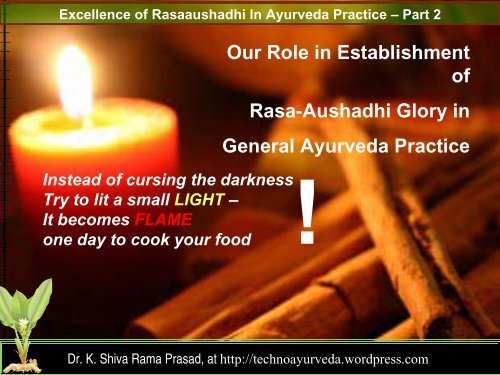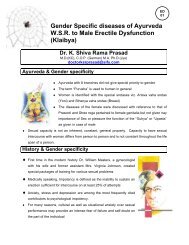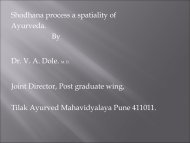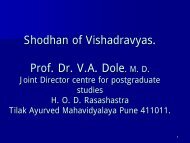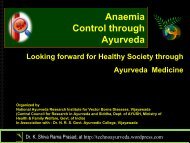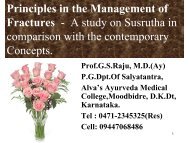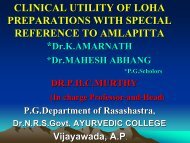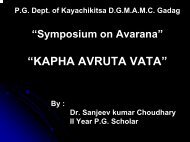Our Role in Establishment of Rasa-Aushadhi ... - Techno Ayurveda
Our Role in Establishment of Rasa-Aushadhi ... - Techno Ayurveda
Our Role in Establishment of Rasa-Aushadhi ... - Techno Ayurveda
Create successful ePaper yourself
Turn your PDF publications into a flip-book with our unique Google optimized e-Paper software.
Excellence <strong>of</strong> <strong>Rasa</strong>aushadhi In <strong>Ayurveda</strong> Practice – Part 2<br />
Instead <strong>of</strong> curs<strong>in</strong>g the darkness<br />
Try to lit a small LIGHT –<br />
It becomes FLAME<br />
one day to cook your food<br />
<strong>Our</strong> <strong>Role</strong> <strong>in</strong> <strong>Establishment</strong><br />
<strong>of</strong><br />
<strong>Rasa</strong>-<strong>Aushadhi</strong> Glory <strong>in</strong><br />
General <strong>Ayurveda</strong> Practice<br />
Dr. K. Shiva Rama Prasad, at http://technoayurveda.wordpress.com/<br />
1
స “రస” ైదుయ్లకు అనందనలో<br />
A<br />
<strong>Techno</strong>ayurveda International<br />
Presentation<br />
In<br />
Association with<br />
Ayurmitra<br />
<strong>Techno</strong>ayurveda.wordpress.com<br />
<strong>Rasa</strong>shastra Re-Orientation Program at<br />
NRS Govt. <strong>Ayurveda</strong> College, Vijayawada<br />
on 15-12-2009<br />
2
Excellence <strong>of</strong> <strong>Rasa</strong>aushadhi In <strong>Ayurveda</strong> Practice<br />
<strong>Rasa</strong> <strong>Aushadhi</strong> Common Diseases <strong>in</strong> GAP Research <strong>in</strong> RT<br />
Dhatuvada - Dehavedha<br />
न च रसशास्तर्ं धातुवादाथर्मेवेित मन्तव्यं<br />
देहवेधद्वार मुक्ते रेव परमूयोजनत्वात्<br />
रसेश्वर दशर्न<br />
‣ Conversion <strong>of</strong> the lower metals to higher is<br />
the job <strong>of</strong> “Chemistry”.<br />
‣ What is expected from “<strong>Rasa</strong>shastra” is to<br />
make is the “Dehavedha” for the body to<br />
atta<strong>in</strong> the “Mukti” from “Disease”<br />
Dr. K. Shiva Rama Prasad, at http://technoayurveda.wordpress.com/<br />
3
Excellence <strong>of</strong> <strong>Rasa</strong>aushadhi In <strong>Ayurveda</strong> Practice<br />
<strong>Rasa</strong> <strong>Aushadhi</strong> Common Diseases <strong>in</strong> GAP Research <strong>in</strong> RT<br />
Introduction<br />
• <strong>Rasa</strong>shastra a Scientific Chemotherapy<br />
<strong>of</strong> <strong>Ayurveda</strong> is at Cross-Roads<br />
• The <strong>in</strong>fluences and advancements <strong>of</strong> -<br />
– “Pharmacy standards”<br />
– “Evidence Based Medic<strong>in</strong>e protocols”<br />
– A major Global “Toxic concept campaign” and<br />
– “<strong>Ayurveda</strong> Fraternity Deception”<br />
• - are mak<strong>in</strong>g panic to the <strong>Ayurveda</strong><br />
community <strong>in</strong> general and <strong>Rasa</strong>shastra<br />
(Pharmacy) division <strong>in</strong> specific.<br />
Dr. K. Shiva Rama Prasad, at http://technoayurveda.wordpress.com/<br />
4
Excellence <strong>of</strong> <strong>Rasa</strong>aushadhi In <strong>Ayurveda</strong> Practice<br />
<strong>Rasa</strong> <strong>Aushadhi</strong> Common Diseases <strong>in</strong> GAP Research <strong>in</strong> RT<br />
<strong>Ayurveda</strong> <strong>in</strong> Research<br />
• The Excellency to br<strong>in</strong>g back – Research <strong>in</strong><br />
the any branch especially <strong>in</strong> <strong>Rasa</strong>shastra is<br />
essential.<br />
• <strong>Ayurveda</strong> has many units <strong>of</strong> Research like –<br />
CCRAS, ICMR and many NGOs for mak<strong>in</strong>g<br />
Research and <strong>in</strong>form<strong>in</strong>g the Research fruits<br />
to the user.<br />
– Whether the Researches <strong>in</strong> <strong>Ayurveda</strong> are<br />
User demand fulfillments<br />
– Are the Researches followed are up to<br />
the International standard to accept<br />
Globally our Medic<strong>in</strong>e<br />
– Are we make user to satisfy by the –<br />
• “Standard”<br />
• “Effect” or<br />
• “Free <strong>of</strong> Toxicity”<br />
• By any other way . . . At least . . .<br />
Dr. K. Shiva Rama Prasad, at http://technoayurveda.wordpress.com/<br />
5
Excellence <strong>of</strong> <strong>Rasa</strong>aushadhi In <strong>Ayurveda</strong> Practice<br />
<strong>Rasa</strong> <strong>Aushadhi</strong> Common Diseases <strong>in</strong> GAP Research <strong>in</strong> RT<br />
Need <strong>of</strong> the Hour<br />
• To be frank the researches <strong>in</strong> <strong>Ayurveda</strong><br />
are not user friendly and could not reach<br />
the ultimate user – General <strong>Ayurveda</strong><br />
Practitioner<br />
• As we are at the <strong>Rasa</strong>shastra researches<br />
<strong>in</strong> concern at present – it is necessary to<br />
know how the researches are made <strong>in</strong> this<br />
branch.<br />
Dr. K. Shiva Rama Prasad, at http://technoayurveda.wordpress.com/<br />
6
Excellence <strong>of</strong> <strong>Rasa</strong>aushadhi In <strong>Ayurveda</strong> Practice<br />
<strong>Rasa</strong> <strong>Aushadhi</strong> Common Diseases <strong>in</strong> GAP Research <strong>in</strong> RT<br />
Research <strong>in</strong> General<br />
• Researches are <strong>of</strong> many folds to obta<strong>in</strong><br />
the “True Knowledge” – A search aga<strong>in</strong><br />
and aga<strong>in</strong> to get the perfect knowledge.<br />
• Commonly followed are –<br />
– 1. Explorative Research<br />
• Literary<br />
• Experience survey<br />
– 2. Conclusive<br />
• Descriptive<br />
• Experimental<br />
Dr. K. Shiva Rama Prasad, at http://technoayurveda.wordpress.com/<br />
7
Excellence <strong>of</strong> <strong>Rasa</strong>aushadhi In <strong>Ayurveda</strong> Practice<br />
<strong>Rasa</strong> <strong>Aushadhi</strong> Common Diseases <strong>in</strong> GAP Research <strong>in</strong> RT<br />
Research Process<br />
• Problem def<strong>in</strong>ition<br />
• Objectives set: purpose – place – status - means<br />
– Research questions<br />
– Hypothesis<br />
– Boundary <strong>of</strong> the study<br />
• Research design<br />
– Sampl<strong>in</strong>g – experiment – questioners<br />
• Data collection<br />
• Data analysis<br />
• Interpretation <strong>of</strong> results – should be with real world<br />
problem and conclusion<br />
• Validation <strong>of</strong> results<br />
Dr. K. Shiva Rama Prasad, at http://technoayurveda.wordpress.com/<br />
8
Excellence <strong>of</strong> <strong>Rasa</strong>aushadhi In <strong>Ayurveda</strong> Practice<br />
shadhi Common Diseases <strong>in</strong> GAP Research <strong>in</strong> RT Activity <strong>in</strong> Research<br />
Is <strong>Rasa</strong>-Medic<strong>in</strong>e is Target oriented<br />
<strong>Rasa</strong> Parpati<br />
Parada<br />
Samanya<br />
Shodhana<br />
Gandhaka<br />
Samanya Shodhana<br />
Ghrita Bharjita<br />
Bhr<strong>in</strong>garaja<br />
Godugdha<br />
Shodhita<br />
Gandhaka<br />
Lashuna + Sa<strong>in</strong>dhava<br />
with Lime Powder<br />
H<strong>in</strong>gulottha<br />
Parada<br />
Parpati 1 <strong>of</strong> 2<br />
Parpati 2 <strong>of</strong> 4<br />
hodhita Parada What Target differences are brought <strong>in</strong> usage <strong>of</strong> these<br />
comb<strong>in</strong>ations and permutations with set <strong>of</strong> comb<strong>in</strong>ations<br />
and permutations <strong>of</strong> Anupana, Sahapana <strong>in</strong> General<br />
<strong>Ayurveda</strong> Practice<br />
Dr. K. Shiva Rama Prasad, at http://technoayurveda.wordpress.com/<br />
9
Excellence <strong>of</strong> <strong>Rasa</strong>aushadhi In <strong>Ayurveda</strong> Practice<br />
shadhi Common Diseases <strong>in</strong> GAP Research <strong>in</strong> RT Activity <strong>in</strong> Research<br />
Is <strong>Rasa</strong>-Medic<strong>in</strong>e is Target oriented<br />
A cutt<strong>in</strong>g edge technology is the need <strong>of</strong> hour <strong>in</strong> <strong>Ayurveda</strong>.<br />
The road beyond Production & Practice should be visualized.<br />
Dravya Shodhana Probable<br />
Parada H<strong>in</strong>gulotha (Alimentary) Pittahara<br />
Lime powder<br />
(Ca+)(neural) Vatahara<br />
Lasuna +<br />
Sa<strong>in</strong>dhava<br />
(Tissue <strong>in</strong>vader)<br />
Kaphahara<br />
Gandhaka Godugdha Agni<br />
Bhr<strong>in</strong>garaj Panchabhutagni<br />
Whether the “Shodhana” makes the Dravya to reorganize the Chemical bond<strong>in</strong>g<br />
Dr. K. Shiva Rama Prasad, at http://technoayurveda.wordpress.com/<br />
10
Parpati <strong>in</strong> Practice<br />
Parpati Additives Target<br />
<strong>Rasa</strong><br />
Panchamruta<br />
<strong>Rasa</strong> + Gandhaka<br />
(Base comb<strong>in</strong>ation)<br />
+ Loha, Abhraka<br />
Tamra<br />
Annavaha, Udakavaha<br />
<strong>Rasa</strong>vaha, Lasika (Twak)<br />
Annavaha, Pranavaha<br />
Sukravaha<br />
Bola + Bola Rakta vaha, Artavavaha<br />
Loha + Loha Annavaha, Lasika (Twak)<br />
Swarna + Swarna Annavaha, Pranavaha<br />
Sukravaha<br />
Tamra<br />
Sweta<br />
Excellence <strong>of</strong> <strong>Rasa</strong>aushadhi In <strong>Ayurveda</strong> Practice<br />
shadhi Common Diseases <strong>in</strong> GAP Research <strong>in</strong> RT Activity <strong>in</strong> Research<br />
+ Tamra,<br />
Vatsanabha<br />
Soraka, Sphatika,<br />
Navasara<br />
Annavaha, Mootravaha<br />
Lasika (Twak)<br />
Annavaha, Mootravaha<br />
Dr. K. Shiva Rama Prasad, at http://technoayurveda.wordpress.com/<br />
11
Excellence <strong>of</strong> <strong>Rasa</strong>aushadhi In <strong>Ayurveda</strong> Practice<br />
shadhi Common Diseases <strong>in</strong> GAP Research <strong>in</strong> RT Activity <strong>in</strong> Research<br />
Raw drug collection - Identification<br />
Who Answers <br />
Pharmaceutical<br />
Ingredient<br />
Shodhana<br />
S<strong>in</strong>gle / Multiple<br />
Shodhita<br />
Ingredients<br />
Multiple Bhavana<br />
Multiple Preparation<br />
methods<br />
Marana<br />
Multi<br />
comb<strong>in</strong>ations<br />
Multiple Pharmacok<strong>in</strong>etics<br />
Multiple Pharmacodynamics<br />
Anupana<br />
Is there any Genotoxicity <br />
Drug Target Action<br />
Sahapana<br />
Aushadha Kaala<br />
Drug concentrations<br />
to ma<strong>in</strong>ta<strong>in</strong> half life<br />
Drug Excretion <br />
Cl<strong>in</strong>ical<br />
attitudes<br />
Dr. K. Shiva Rama Prasad, at http://technoayurveda.wordpress.com/<br />
12
Excellence <strong>of</strong> <strong>Rasa</strong>aushadhi In <strong>Ayurveda</strong> Practice<br />
shadhi Common Diseases <strong>in</strong> GAP Research <strong>in</strong> RT Activity <strong>in</strong> Research<br />
Another Example <strong>of</strong> Kupipakwa <strong>Rasa</strong>yana<br />
• In Kupi pakwa <strong>Rasa</strong>yana procedures – the medic<strong>in</strong>e<br />
collection is from the “Talastha” or “Kantastha” and<br />
“Ubhayastha”.<br />
• Tak<strong>in</strong>g the example <strong>of</strong> “Somanatha tamra Bhasma and<br />
Malla S<strong>in</strong>dhura (Tamra s<strong>in</strong>dhura) are from one preparation.<br />
– The “Kantastha” – called as Tamra Sidhura acts on STI, Tamaka<br />
Swasa<br />
– Where as – the “Talastha” collection called as Tamra Bhasma<br />
acts on – many diseases, especially on Annvaha, Pranavaha,<br />
Twak vikara, etc.<br />
• What makes the difference <strong>of</strong> collection <strong>in</strong> a process<br />
• Whether the target is to prepare one medic<strong>in</strong>e <strong>in</strong> a<br />
pharmaceutical procedure or two Birds <strong>in</strong> one shot<br />
• Does such short cut methods are encouraged by the Learned<br />
community<br />
Dr. K. Shiva Rama Prasad, at http://technoayurveda.wordpress.com/<br />
13
Excellence <strong>of</strong> <strong>Rasa</strong>aushadhi In <strong>Ayurveda</strong> Practice<br />
mmon Diseases <strong>in</strong> GAP Research <strong>in</strong> RT Activity <strong>in</strong> Research Research Methods to Adopt<br />
What Literary Research<br />
• Literary research <strong>in</strong> <strong>Rasa</strong>shastra has a<br />
wide scope and is the need <strong>of</strong> the hour.<br />
• The pr<strong>in</strong>t available <strong>Rasa</strong>shastra books are<br />
few and the abundance <strong>of</strong> Manuscripts<br />
makes – a chance to explore <strong>Rasa</strong>shastra.<br />
• For Eg. – a preparation have many<br />
dialects <strong>of</strong> preparation methods –<br />
scrut<strong>in</strong>iz<strong>in</strong>g them makes us to have a<br />
target oriented potent Medic<strong>in</strong>e to reach.<br />
Dr. K. Shiva Rama Prasad, at http://technoayurveda.wordpress.com/<br />
14
Excellence <strong>of</strong> <strong>Rasa</strong>aushadhi In <strong>Ayurveda</strong> Practice<br />
mmon Diseases <strong>in</strong> GAP Research <strong>in</strong> RT Activity <strong>in</strong> Research Research Methods to Adopt<br />
How to survey <strong>in</strong> RT<br />
• Survey and education <strong>of</strong> <strong>Rasa</strong> medic<strong>in</strong>e<br />
usage <strong>in</strong> the practice is recorded –<br />
– What is the need for Practitioner<br />
• Symptom target<br />
• Disease target<br />
• Organ target<br />
• System target<br />
• Health target<br />
– What medic<strong>in</strong>es are caus<strong>in</strong>g the adverse<br />
effects – Classified Record<strong>in</strong>gs <strong>of</strong> -<br />
• Hypersensitivity<br />
• Hepato toxicity<br />
• Nephro toxicity<br />
• Neuro toxicity<br />
Dr. K. Shiva Rama Prasad, at http://technoayurveda.wordpress.com/<br />
15
Excellence <strong>of</strong> <strong>Rasa</strong>aushadhi In <strong>Ayurveda</strong> Practice<br />
mon Diseases <strong>in</strong> GAP Research <strong>in</strong> RT Activity <strong>in</strong> Research Research Methods to Adopt<br />
Do we do Descriptive Research <strong>in</strong> RT<br />
• Much <strong>of</strong> the present day Researches are<br />
follow<strong>in</strong>g the Descriptive Method researches<br />
– which are with limited scope - as –<br />
• Prospective study – common<br />
– Physico / Pharmaco -chemical studies<br />
– Drug effect <strong>in</strong> cl<strong>in</strong>ical study<br />
• Retrospective study – Reverse<br />
pharmacology study - uncommon <strong>in</strong><br />
<strong>Ayurveda</strong><br />
Dr. K. Shiva Rama Prasad, at http://technoayurveda.wordpress.com/<br />
16
Excellence <strong>of</strong> <strong>Rasa</strong>aushadhi In <strong>Ayurveda</strong> Practice<br />
Research <strong>in</strong> RT Activity <strong>in</strong> Research Research Methods to Adopt Research Models<br />
Experimental Research <strong>in</strong> RT<br />
Experimental studies have no pickup <strong>in</strong><br />
<strong>Ayurveda</strong> because <strong>of</strong> non-efficiencies<br />
/exposure <strong>in</strong> ma<strong>in</strong>tenance <strong>of</strong> –<br />
Animal Houses and<br />
Analytical lab.<br />
The limp<strong>in</strong>g or dependent studies are<br />
successful some times but not yield<strong>in</strong>g<br />
the full-fledged fruits and results to the<br />
<strong>Ayurveda</strong> community.<br />
More systematic animal experiments<br />
and lab studies are required as the<br />
AYUSH is fund<strong>in</strong>g and encourag<strong>in</strong>g for<br />
the “Expressive Projects”<br />
Dr. K. Shiva Rama Prasad, at http://technoayurveda.wordpress.com/<br />
17
Excellence <strong>of</strong> <strong>Rasa</strong>aushadhi In <strong>Ayurveda</strong> Practice<br />
Activity <strong>in</strong> Research Research Methods to Adopt Research Models<br />
Research Models <strong>in</strong> RT<br />
• Best Research model for successful<br />
Penetration Rat<strong>in</strong>g <strong>in</strong> to market is through<br />
fulfill<strong>in</strong>g the peoples needs –<br />
• Mathematical –<br />
– Inventory<br />
– Parametric<br />
– Replacement<br />
• Algorithmic – is a well-def<strong>in</strong>ed sequence steps<br />
to solve a problem<br />
– Comb<strong>in</strong>ational<br />
– Polynomial<br />
Dr. K. Shiva Rama Prasad, at http://technoayurveda.wordpress.com/<br />
18
Excellence <strong>of</strong> <strong>Rasa</strong>aushadhi In <strong>Ayurveda</strong> Practice<br />
Activity <strong>in</strong> Research Research Methods to Adopt Research Models<br />
Inventory Research<br />
• Present day researches seems to validate ancient<br />
formulations rather than productivity<br />
• No contribution <strong>of</strong> the “Neo-<strong>Rasa</strong>shastra” is<br />
brought forward<br />
• An <strong>in</strong>ventory model is –<br />
– Classify and visualize the old formula as TLC, HPTC,<br />
F<strong>in</strong>ger pr<strong>in</strong>t technology, etc<br />
– Chemical structure is identified<br />
– Reconstruct the cha<strong>in</strong>s for validation and comparison<br />
– Restructure the comb<strong>in</strong>ation to the needs <strong>of</strong> user<br />
– Rejuvenation <strong>of</strong> Vedic Chemistry<br />
– There by combat<strong>in</strong>g the present day dreadful diseases<br />
Dr. K. Shiva Rama Prasad, at http://technoayurveda.wordpress.com/<br />
19
Excellence <strong>of</strong> <strong>Rasa</strong>aushadhi In <strong>Ayurveda</strong> Practice<br />
Activity <strong>in</strong> Research Research Methods to Adopt Research Models<br />
Parametric Research<br />
• A classical design <strong>of</strong> Research (validation)–<br />
mere Chemical constituents – studied with -<br />
– Pre-fixed Parameters<br />
– Chemical structure evaluated<br />
– Limited framework to study<br />
• A locality<br />
• One medic<strong>in</strong>e<br />
• Small duration<br />
– Mono-directional<br />
– Target based<br />
– Result oriented<br />
Dr. K. Shiva Rama Prasad, at http://technoayurveda.wordpress.com/<br />
20
Excellence <strong>of</strong> <strong>Rasa</strong>aushadhi In <strong>Ayurveda</strong> Practice<br />
Activity <strong>in</strong> Research Research Methods to Adopt Research Models<br />
Replacement Research<br />
• In <strong>Ayurveda</strong> – we are commonly us<strong>in</strong>g the<br />
substitutes –<br />
– Whether the replacements are equivalent<br />
– Does they give exactly results as their substitutes<br />
– we don’t know!<br />
• Instead – us<strong>in</strong>g Replacement Research is<br />
better – here we replace with –<br />
– Standard replacement<br />
– Equivalent replacement (based on <strong>Rasa</strong>, Guna, etc)<br />
– Omitt<strong>in</strong>g replacement<br />
– Complete replacement<br />
Dr. K. Shiva Rama Prasad, at http://technoayurveda.wordpress.com/<br />
21
Excellence <strong>of</strong> <strong>Rasa</strong>aushadhi In <strong>Ayurveda</strong> Practice<br />
Research Methods to Adopt Research Models GAP <strong>in</strong> Research Conclusion<br />
Comb<strong>in</strong>ational Research<br />
• The medic<strong>in</strong>es commonly used are <strong>of</strong> Herbom<strong>in</strong>eral<br />
comb<strong>in</strong>ations<br />
• The comb<strong>in</strong>ational research <strong>in</strong> <strong>Rasa</strong>shastra is<br />
def<strong>in</strong>ed as –<br />
– A team <strong>of</strong> <strong>Rasa</strong>shastra - Chemistry –<br />
Botany – Pharmacy – <strong>Ayurveda</strong> Specialized<br />
Branch - are together to work on a<br />
compound – unbiased<br />
– Various methods <strong>of</strong> said preparations are<br />
compared for the – structure – safety<br />
(Toxicity) – economy - efficacy –<br />
Dr. K. Shiva Rama Prasad, at http://technoayurveda.wordpress.com/<br />
22
Excellence <strong>of</strong> <strong>Rasa</strong>aushadhi In <strong>Ayurveda</strong> Practice<br />
Research Methods to Adopt Research Models GAP <strong>in</strong> Research Conclusion<br />
Polynomial Research<br />
• It is def<strong>in</strong>ed as - A mathematical function that is<br />
the sum <strong>of</strong> a number <strong>of</strong> terms –<br />
– As the standards <strong>of</strong> the <strong>Ayurveda</strong> are unique and not<br />
fit to the “Rest <strong>of</strong> the World” –<br />
• A multi center – large sample – uni-directional studies are<br />
<strong>in</strong>vited<br />
– This is possible by the universities or CCRAS or ICMR –<br />
creat<strong>in</strong>g a Nodal <strong>of</strong>ficer to control the studies all over – even the<br />
PG Centers<br />
• A common m<strong>in</strong>imum policy is created to ensure<br />
the<br />
– Drug Safety<br />
– Half life<br />
– Target area and<br />
– Excretion<br />
Dr. K. Shiva Rama Prasad, at http://technoayurveda.wordpress.com/<br />
23
Excellence <strong>of</strong> <strong>Rasa</strong>aushadhi In <strong>Ayurveda</strong> Practice<br />
Research Methods to Adopt Research Models GAP <strong>in</strong> Research Conclusion<br />
Reverse Pathology – Reverse Pharmacology<br />
• Reverse pathology <strong>in</strong> <strong>Ayurveda</strong> is said as – Samprapti<br />
Vighatana<br />
• Plann<strong>in</strong>g <strong>of</strong> the Vighatana with the comb<strong>in</strong>ation is the<br />
most important task <strong>in</strong> <strong>Ayurveda</strong> Practice. It is possible<br />
with the understand<strong>in</strong>g <strong>of</strong> <strong>Ayurveda</strong> pr<strong>in</strong>ciples and<br />
application <strong>of</strong> –<br />
– <strong>Rasa</strong><br />
– Guna<br />
– Veerya<br />
– Vipaka<br />
– Prabhava<br />
• Reverse Pharmacology is understood under the present<br />
day technology about –<br />
– Drug Excretion<br />
– Drug target<br />
– Half life, etc<br />
Dr. K. Shiva Rama Prasad, at http://technoayurveda.wordpress.com/<br />
24
Excellence <strong>of</strong> <strong>Rasa</strong>aushadhi In <strong>Ayurveda</strong> Practice<br />
Research Methods to Adopt Research Models GAP <strong>in</strong> Research Conclusion<br />
Example • Madhumeha patho-physiology is –<br />
• Bahumootrantaka Ras – Tissues <strong>of</strong> body are liquidated -<br />
used <strong>in</strong> Madhumeha has – – The sugar reserves undertakes neo-<br />
• Ahiphena<br />
glucogenesis<br />
• Dadima<br />
– Non utilization <strong>of</strong> CHO by muscles or<br />
• Kadali<br />
even for transformation <strong>in</strong> to deposits<br />
• Parad<br />
– Free CHO (Shareera Kleda) mix with<br />
• Loha<br />
fluids (Ap Dhatu) <strong>of</strong> the body<br />
• Mouktika<br />
especially Rakta<br />
• Praval<br />
– Expresses as “Bahudrava shleshma<br />
• Shalmali<br />
yukta – Madhurakta”<br />
• Udumbara<br />
– The liquids mixed with CHO <strong>of</strong> the<br />
• Vanga<br />
body are transported to the KUB –<br />
termed as - Madhumeha<br />
– i.e. Elim<strong>in</strong>ation <strong>of</strong> excess fluids along<br />
with Shareera Kleda (Glucose)<br />
– The reverse pathology planned on<br />
these grounds are – <strong>in</strong> RED – &<br />
– Fluid Regulation<br />
– CHO Regulation<br />
Dr. K. Shiva Rama Prasad, at http://technoayurveda.wordpress.com/<br />
25
Excellence <strong>of</strong> <strong>Rasa</strong>aushadhi In <strong>Ayurveda</strong> Practice<br />
Research Methods to Adopt Research Models GAP <strong>in</strong> Research Conclusion<br />
Repatriation Hypothesis i.e. Reverse Pathology<br />
Ahiphena paralyzes<br />
sigmoid smooth<br />
mussels & Dadima<br />
prevents the fluid<br />
re absorption from<br />
colon by reverse<br />
peristalsis, Loha<br />
require maximum<br />
fluid for synthesis<br />
and absorbs the<br />
water once aga<strong>in</strong> –<br />
so, the fluid reentry<br />
<strong>in</strong> to system<br />
is regulated at the<br />
same time Shalmali<br />
absorbs the fluid <strong>in</strong><br />
the colon<br />
Same time the Ur<strong>in</strong>e reabsorption<br />
from Henley's loop<br />
is retarded by Vanga, and<br />
Kadali<br />
- Udumbara makes the<br />
<strong>in</strong>tegumentary system<br />
(Lasika) to constra<strong>in</strong> and fluid<br />
reta<strong>in</strong>ed is dra<strong>in</strong>ed back to<br />
system<br />
1<br />
2<br />
Fluid Regulation<br />
Dr. K. Shiva Rama Prasad, at http://technoayurveda.wordpress.com/<br />
26
Excellence <strong>of</strong> <strong>Rasa</strong>aushadhi In <strong>Ayurveda</strong> Practice<br />
Research Methods to Adopt Research Models GAP <strong>in</strong> Research Conclusion<br />
Repatriation Hypothesis i.e. Reverse Pathology<br />
CHO Regulation<br />
Formation <strong>of</strong> shareera<br />
kleda – CHO is<br />
through Liver (Mamsa<br />
Khanda) and<br />
Pancreas – there by<br />
the Parada acts as<br />
agent to and prevents<br />
the neo-glycolysis<br />
3<br />
CHO combustion is done<br />
through rapid muscle<br />
movements by <strong>in</strong>itiat<strong>in</strong>g<br />
Acetylchol<strong>in</strong>e at motor<br />
endplates <strong>in</strong> muscle fiber<br />
through - Mouktika –<br />
Pravala<br />
Heat generated with<br />
muscle movement makes<br />
the bahudrava shleshma<br />
to evaporate<br />
5<br />
Shalmali, Parada<br />
<strong>in</strong>itiates the<br />
pancreas to regulate<br />
the CHO<br />
Dr. K. Shiva Rama Prasad, at http://technoayurveda.wordpress.com/<br />
4<br />
27
Excellence <strong>of</strong> <strong>Rasa</strong>aushadhi In <strong>Ayurveda</strong> Practice<br />
Activity <strong>in</strong> Research Research Methods to Adopt Research Models GAP <strong>in</strong> Research<br />
GAP Research Models<br />
• General <strong>Ayurveda</strong> Practitioners Research<br />
models are with –<br />
– Involved Data base record<strong>in</strong>g and<br />
– submission to the nearest center for analysis –<br />
as a part <strong>of</strong> big survey<br />
• Suggest<strong>in</strong>g the center for –<br />
– epidemic and endemic events and<br />
– actively participat<strong>in</strong>g <strong>in</strong> Health campaigns with<br />
– Evidence based Research drugs provided by<br />
the center <strong>in</strong> time<br />
Dr. K. Shiva Rama Prasad, at http://technoayurveda.wordpress.com/<br />
28
Excellence <strong>of</strong> <strong>Rasa</strong>aushadhi In <strong>Ayurveda</strong> Practice<br />
Activity <strong>in</strong> Research Research Methods to Adopt Research Models GAP <strong>in</strong> Research<br />
• Area specific diseases are submitted and a common drug<br />
therapy modules are adopted as per the centers advise<br />
• Center responsibilities -<br />
GAP Research Models<br />
– Periodical CME for the practitioners with <strong>in</strong> 50 -100 KM<br />
diameter<br />
– Door to door survey <strong>of</strong> health / disease conditions<br />
– Provid<strong>in</strong>g Easy access to the people about pro and<br />
cant's <strong>of</strong> drug<br />
– Life l<strong>in</strong>e access through telephone / Internet <strong>in</strong><br />
Institutional / Hospital centers<br />
– Radio talks / TV shows / FM Radio services organized<br />
to create Awareness to the Local people<br />
Dr. K. Shiva Rama Prasad, at http://technoayurveda.wordpress.com/<br />
29
Excellence <strong>of</strong> <strong>Rasa</strong>aushadhi In <strong>Ayurveda</strong> Practice<br />
Research Methods to Adopt Research Models GAP <strong>in</strong> Research Conclusion<br />
Responsibilities <strong>of</strong> Practitioner<br />
• Reclassify the usage <strong>of</strong> <strong>Rasa</strong>aushadhi <strong>in</strong><br />
– Infectious<br />
– Metabolic<br />
– Emergencies, etc<br />
• Diseases <strong>of</strong> attention<br />
– AIDS<br />
– Cancer<br />
– ED<br />
– Paralysis<br />
• Develop<strong>in</strong>g the databank for EB Ay Medic<strong>in</strong>e<br />
• Def<strong>in</strong><strong>in</strong>g the <strong>Rasa</strong>ushadhi <strong>in</strong> Departmental use –<br />
Shalya, Prasuthi, etc.<br />
• Suggestion <strong>of</strong> Contribution required <strong>in</strong> practice<br />
• Ethical practices <strong>in</strong> <strong>Rasa</strong> practice<br />
Dr. K. Shiva Rama Prasad, at http://technoayurveda.wordpress.com/<br />
30
Excellence <strong>of</strong> <strong>Rasa</strong>aushadhi In <strong>Ayurveda</strong> Practice<br />
Research Methods to Adopt Research Models GAP <strong>in</strong> Research Conclusion<br />
• The Interference <strong>of</strong> too many or<br />
• No <strong>in</strong>volvement<br />
Conclusion<br />
– is the problem <strong>in</strong> <strong>Ayurveda</strong> Research<br />
• Develop<strong>in</strong>g Teamwork <strong>in</strong>stead & Work<strong>in</strong>g<br />
Unbiased <strong>in</strong> the Research and <strong>in</strong>corporat<strong>in</strong>g<br />
<strong>Rasa</strong>aushadhi vividly <strong>in</strong> General <strong>Ayurveda</strong> Practice<br />
are the solutions for development - because ….<br />
–आरोग्यम ् (रस) भाःकरािदच्छेत ्<br />
Dr. K. Shiva Rama Prasad, at http://technoayurveda.wordpress.com/<br />
31
Excellence <strong>of</strong> <strong>Rasa</strong>aushadhi In <strong>Ayurveda</strong> Practice – Part 2<br />
technoayurveda@gmail.com<br />
THANK YOU<br />
Dr. K. Shiva Rama Prasad<br />
Of . . . technoayurveda.wordpress.com It’s<br />
<strong>Techno</strong>ayurveda on International<br />
Excellence <strong>of</strong> <strong>Rasa</strong>aushadhi In <strong>Ayurveda</strong> Presentation Practice<br />
Dr. K. Shiva Rama Prasad, Pr<strong>of</strong>essor & Head, Kayachikitsa, Amrita School <strong>of</strong> <strong>Ayurveda</strong>, Kerala<br />
32


